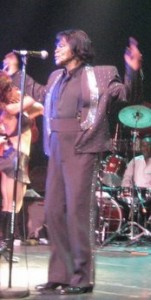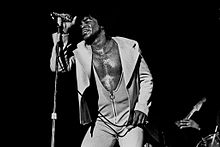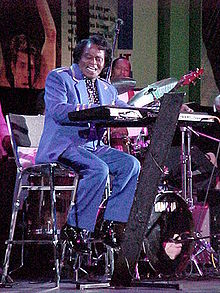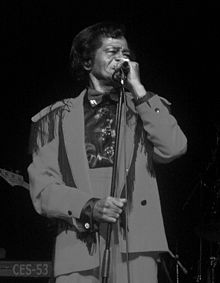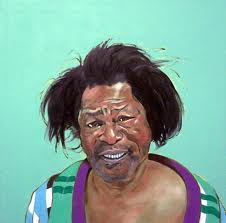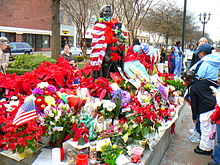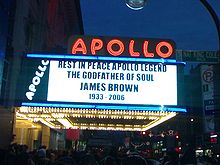James Brown
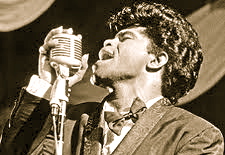
Soul Survivor – The James Brown Story
James Brown performing on June 27, 2005
James Joseph Brown (May 3, 1933 – December 25, 2006) was an American singer, songwriter, musician, and recording artist. He is one of the founding fathers of funk music and is a major figure of 20th century popular music and dance. In a career that spanned six decades, Brown profoundly influenced the development of many different musical genres. Brown moved on a continuum of blues and gospel-based forms and styles to a profoundly “Africanized” approach to music making. First coming to national public attention in the mid-1950s as a member of the R&B singing group The Famous Flames, Brown performed in concerts, first making his rounds across the chitlin’ circuit, and then across the country and later around the world, along with appearing in shows on television and in movies. Although he contributed much to the music world through his hitmaking, Brown holds the record as the artist who charted the most singles on the Billboard Hot 100 without ever hitting number one on that chart.
For many years, Brown’s touring show was one of the most extravagant productions in American popular music. At the time of Brown’s death, his band included three guitarists, two bass guitar players, two drummers, three horns and a percussionist. The bands that he maintained during the late 1960s and 1970s were of comparable size, and the bands also included a three-piece amplified string section that played during ballads. Brown employed between 40 and 50 people for the James Brown Revue, and members of the revue traveled with him in a bus to cities and towns all over the country, performing upwards of 330 shows a year with almost all of the shows as one-nighters. In 1986, he was inducted into the Rock and Roll Hall of Fame and in 2000 into the Songwriters Hall of Fame. He is ranked seventh on Rolling Stone magazine’s list of the “100 Greatest Artists of All Time.”
Brown died on Christmas Day 2006 from heart failure after becoming very ill two days earlier and being hospitalized for hours. He was interred in Beech Island, South Carolina.
James Brown was born in Barnwell, South Carolina on May 3, 1933, to Susie (née Behlings) Brown (August 8, 1916 – February 26, 2004) and Joseph (“Joe”) Gardner (March 29, 1911 – July 10, 1993) (who changed his surname to Brown after Mattie Brown who raised him). Although Brown was to be named after his father Joseph, his first and middle names were mistakenly reversed on his birth certificate. He therefore became James Joseph Brown, Jr. As a young child, Brown was called Junior. When he later lived with his aunt and cousin, he was called Little Junior since his cousin’s nickname was also Junior. Later as an adult, Brown legally changed his name to remove the “Jr.” designation. Brown was of African, Chinese and Native American (Apache) ancestry.
As a young child, Brown and his family lived in extreme poverty in nearby Elko, South Carolina, which was an impoverished town at the time. When Brown was two years old, his parents separated after his mother left his father for another man. After his mother abandoned the family, Brown continued to live with his father and his father’s live-in girlfriends until he was six years old. Subsequently, his father sent him to live with an aunt, who ran a house of prostitution. Even though Brown lived with relatives, he spent long stretches of time on his own, hanging out on the streets and hustling to get by. Brown managed to stay in school until seventh grade. During his childhood, Brown earned money shining shoes, sweeping out stores, selling and trading in old stamps, washing cars and dishes and singing in talent contests. Brown also performed buck dances for change to entertain troops from Camp Gordon at the start of World War II as their convoys traveled over a canal bridge near his aunt’s home. Between earning money, Brown taught himself to play a harmonica given to him by his father. He learned to play some guitar from Tampa Red, in addition to learning to play piano and drums from others he met during this time. Brown was inspired to become an entertainer after watching Louis Jordan, a popular jazz and R&B performer during the 1940s, and Jordan’s Tympany Five performing “Caldonia” in a short film.
Brown began his performing career at age 12, forming his first vocal group, the Cremona Trio in 1945. That same year they won local talent shows at Augusta concert halls such as the Lenox and Harlem theaters. As a result, the group would later perform at several high schools and local army bases. At the age of sixteen, he was convicted of armed robbery and sent to a juvenile detention center in Toccoa. While in prison, he formed a gospel quartet with fellow cell mates Johnny Terry, “Hucklebuck” Davis and a person named “Shag”, and made his own instruments – a comb and paper, a washtub bass, a drum kit made from lard tubs, and what he called “a sort of mandolin [made] out of a wooden box.” Due to the latter instrument, Brown was given his first nickname, “Music Box”. In 1952, while still in reform school, Brown met future R&B legend Bobby Byrd, who was there playing baseball against the reform school team. Byrd saw Brown perform and admired his talent. As a result of this, Byrd’s family helped Brown secure an early release on June 14, 1952 after serving three years of his sentence. The authorities agreed to release Brown on the condition that he would get a job and not return to Augusta or Richmond County and also under the condition that he find a decent job and sing for the Lord – as he had promised in his parole letter. After stints as a boxer and baseball pitcher in semi-professional baseball (a career move ended by a leg injury), Brown turned his energy toward music.
 Career – 1954–1960: The Famous Flames
Career – 1954–1960: The Famous Flames
By 1954, Brown had tried to get a record deal with his gospel group, the Ever Ready Gospel Singers after recording a version of “His Eye Is on the Sparrow“, but returned to Toccoa when that failed. Subsequently, his friend Bobby Byrd asked Brown to join his R&B group, the Avons. There Brown replaced another vocalist, Troy Collins, who had died in a car crash. The group, with Byrd, Brown, Sylvester Keels, Doyle Oglesby, Fred Pulliam, and Johnny Terry, modeled themselves after R&B groups of the day such as The Orioles, The Five Keys, and Billy Ward and His Dominoes. While touring Georgia and South Carolina, they again changed their name to the Toccoa Band to avoid confusion with two other groups also named Avons. During this time, Brown recruited guitarist Nafloyd Scott and added percussionists to the group.
Subsequently the group changed its name again, now becoming The Flames. This line-up, while performing in Macon, Georgia attracted the attention of promoter, Clint Brantley (then agent of Brown’s idol, Little Richard), who suggested they add “Famous” to their name. It was during this time that the group began performing original composition including Brown’s “Goin’ Back to Rome” and a ballad Brown co-wrote with Terry titled “Please, Please, Please“. After Little Richard left Macon for Los Angeles, Brantley booked the band for all the venues where Richard had performed, thus boosting the group’s fame. Before Christmas 1955, Brantley had them record a demo of “Please, Please, Please” for a local Macon radio station. Based on two accounts, “Please, Please, Please” was inspired as follows: Etta James stated that during her first meeting with Brown in Macon, Brown “used to carry around an old tattered napkin with him, because Little Richard had written the words, ‘please, please, please’ on it and James was determined to make a song out of it…”; the remainder of the song materialized after the group heard The Orioles‘ rock ‘n’ roll version of Big Joe Williams‘ hit, “Baby Please Don’t Go,” adapting its melody.
Federal Records president Ralph Bass signed the Famous Flames to his label in February 1956 and let them record the song in Cincinnati’s King Studios. Released the following March, it became the Famous Flames’ first R&B hit, selling over a million copies. Despite the song’s success, other songs such as “I Don’t Know”, “No No No”, “Just Won’t Do Right”, and “Chonnie-On-Chon” failed to chart.
By March 1957, a full year after the release of “Please, Please, Please”, most members of the Famous Flames had left after the group’s new manager, Universal Attractions Agency Chief Ben Bart, insisted that the group’s billing be “James Brown and The Famous Flames.” After Little Richard left show business for the ministry, Brown was asked to fill in for him. This resulted not only in greater popular exposure but also led to the recruitment of members of The Dominions. However, the first single, “That Dood It”, failed to chart, and in late 1958, Brown financed the demo of the ballad, “Try Me.” Released that October, it returned the Famous Flames to the charts and reached No. 1 on the R&B chart in February 1959 becoming the first of 17 chart-topping hits on the R&B chart.
Bolstered by this success, Brown recruited a new band that consisted of saxophonist J. C. Davis, guitarist Bobby Roach, bassist Bernard Odum, trumpeter Roscoe Patrick, saxophonist Albert Corley, drummer Nat Kendrick and his old band mate Bobby Byrd, who had rejoined Brown’s band on organ. This resulted in the next Brown hit, “I Want You So Bad“, which peaked in the Top 20 on the Billboard R&B chart. The newly hailed “James Brown Band” debuted at the Apollo Theater on April 24, 1959, opening forLittle Willie John. Following his dismissal of the 1957–58 Famous Flames lineup, he hired “Baby” Lloyd Stallworth and Bobby Bennett as replacements with Byrd and Johnny Terry returning as members. The lineup of Brown,Byrd, Bennett, Stallworth, and Terry proved to be the permanent and longest-lasting Famous Flames lineup. The confusion concerning the Famous Flames singing group in the eyes of the public was that, for years, the Famous Flames were often mistaken for, and confused with, Brown’s backing band; fellow Famous Flame Byrd was also a member of the backing band at one point. Initially a vocal and instrumental group, the Famous Flames, after signing with Federal, developed into a straight vocal group, a separate entity from the James Brown Band. In early 1960, Brown’s band recorded the top ten R&B hit, “(Do the) Mashed Potatoes” on Dade Records, owned by Henry Stone, under the pseudonym “Nat Kendrick & The Swans” because Brown’s label refused to release it. As a result of this, Syd Nathan decided to shift Brown’s contract from Federal to Federal’s parent label, King Records.
 1960–1966: Commercial breakthrough
1960–1966: Commercial breakthrough
By 1960, having been influenced more by jazz music than blues, Brown began incorporating jazz styled arrangements in his music, with Brown naming the Famous Flames hits “I’ll Go Crazy” and “Think” as examples of his changing style away from more traditional forms of R&B and rock ‘n’ roll. Following two albums, Please, Please, Please and Try Me!, credited “James Brown and The Famous Flames”, Think! was the first album issued solely in Brown’s name. Brown’s next albums displayed a range from vocal performances to instrumentals. Brown’s band recorded the instrumental hit, “Night Train“, which was among the first to credit Brown as composer, and which became a Top 5 R&B hit and even briefly crossed over into the Top 40 of the Billboard Hot 100. The ballad “Lost Someone” became, along with “Please, Please, Please”, an early show-stopper during Brown’s performances, while the recording of the Joe Tex composition, “Baby You’re Right” (which Brown altered substantially), increased his reputation with R&B audiences.
On October 24, 1962, Brown financed a live recording of a midnight performance at the Apollo and convinced Syd Nathan to release the album. Nathan felt that, because everyone had already bought the singles Brown performed live on this recording, no one would be interested in an album that contained no new material, and he warned Brown that live albums usually were bad sellers. Brown refused to listen, and thus the album, Live at the Apollo was released. The album was a great success, reaching No. 2 on the pop chart and selling a million copies; it stayed on the charts for fourteen months. Influenced by the crossover success of Ray Charles, Brown began to perform pop standards and succeeded with his first Top 20 single, “Prisoner of Love“. That year, Brown also launched Try Me Records, releasing records by Tammy Montgomery, Johnny & Bill (Famous Flame Johnny Terry and former Flame Bill Hollings), and the Poets (the latter composed of members of Brown’s backing band).
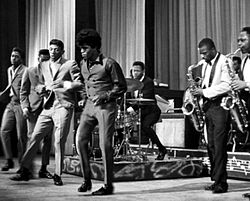 Brown (middle) & The Famous Flames (far left to right, Bobby Bennett, Lloyd Stallworth, andBobby Byrd), performing live at the Apollo Theater in New York City, 1964
Brown (middle) & The Famous Flames (far left to right, Bobby Bennett, Lloyd Stallworth, andBobby Byrd), performing live at the Apollo Theater in New York City, 1964
In 1964, figuring his deal with King was at an end, Brown and fellow Famous Flame Bobby Byrd formed the production company, Fair Deal, linking the operation to a new label, Mercury imprint Smash Records. However, King Records fought Brown’s departure and was granted an injunction preventing Brown from releasing any vocal recordings for his new label. Prior to this injunction, Brown had already released three vocal singles, including a cover of Louis Jordan‘s “Caldonia“, and the 12-bar blues rock and roll number, “Out of Sight“, which further indicated the direction his sound was going to take. Touring throughout 1964, Brown and The Flames soon grabbed more national attention when they performed an explosive performance in the live concert film The T.A.M.I. Show, where Brown’s energetic dance moves together with the polished choreography and timing of the Famous Flames let them upstage the show’s closing act, The Rolling Stones. In June 1965, King and Brown signed a new recording contract and released “Papa’s Got a Brand New Bag“, which became his first Top 10 hit single, winning Brown his firstGrammy. Later in 1965, King released the uptempo rock ‘n’ roll song, “I Got You (I Feel Good)“, which, in late 1965, reached No. 1 on the R&B charts and, in early 1966, reached the mainstream Top 10, peaking at No. 3. Later in 1966, Brown’s reputation as a hit maker was confirmed with the release of the blues-inspired soul ballad, “It’s a Man’s Man’s Man’s World.”
Brown’s success on the charts continued vastly in 1967. His No. 1 R&B hit that year, “Cold Sweat“, sometimes cited as the first true funk song, was the first of his recordings to contain a drum break and the first that featured a harmony that was reduced to a single chord. The instrumental arrangements on tracks such as “Give It Up Or Turnit A Loose” and “Licking Stick-Licking Stick” (both recorded in 1968) and “Funky Drummer” (recorded in 1969) featured a more developed version of Brown’s mid-1960s style, with the horn section, guitars, bass and drums meshed together in intricate rhythmic patterns based on multiple interlocking riffs.
Changes in Brown’s style that started with “Cold Sweat” also established the musical foundation for Brown’s later hits, such as “I Got the Feelin’” (1968) and “Mother Popcorn” (1969). By this time Brown’s vocals frequently took the form of a kind of rhythmic declamation, not quite sung but not quite spoken, that only intermittently featured traces of pitch or melody. This would become a major influence on the techniques of rapping, which would come to maturity along with hip hop music in the coming decades.
Brown’s style of funk in the late 1960s was based on interlocking syncopated parts: funky bass lines, drum patterns, and iconic guitar riffs. The main guitar ostinatos for “Ain’t It Funky” and “Give It Up or Turn It Loose” (both 1969), are examples of Brown’s refinement of New Orleans funk; irresistibly danceable riffs, stripped down to their rhythmic essence. On both recordings the tonal structure is bare bones. The pattern of attack-points is the emphasis, not the pattern of pitches. It’s as if the guitar is an African drum, or idiophone. Alexander Stewart states that this popular feel was passed along from “New Orleans—through James Brown’s music, to the popular music of the 1970s.” Those same tracks were later resurrected by countless hip-hop musicians from the 1970s onward. As a result, James Brown remains to this day the world’s most sampled recording artist, with “Funky Drummer” itself becoming the most sampled individual piece of music.
“Bring it Up” has an Afro-Cuban guajeo-like structure. In fact, on a 1976 version, Cuban bongos are used. All three of these guitar riffs are based on an onbeat/offbeat structure. Stewart states: “This model, it should be noted, is different from a time line (such as clave and tresillo) in that it is not an exact pattern, but more of a loose organizing principle.”
It was around this time as the musician’s popularity increased that he acquired the nickname, “Soul Brother No. 1”, after failing to win the title “King of Soul” from Solomon Burke during a Chicago gig two years prior. Brown’s recordings during this period influenced musicians across the industry, most notably groups such as Sly and the Family Stone, Funkadelic, Charles Wright & the Watts 103rd Street Rhythm Band, Booker T. & the M.G.’s as well as vocalists such as Edwin Starr, David Ruffin and Dennis Edwards from The Temptations, and Michael Jackson, who, throughout his career, cited Brown as his ultimate idol.
Brown’s band during this period employed musicians and arrangers who had come up through the jazz tradition. He was noted for his ability as a bandleader and songwriter to blend the simplicity and drive of R&B with the rhythmic complexity and precision of jazz. Trumpeter Lewis Hamlin and saxophonist/keyboardist Alfred “Pee Wee” Ellis (the successor to previous bandleader Nat Jones) led the band. Guitarist Jimmy Nolen provided percussive, deceptively simple riffs for each song, and Maceo Parker‘s prominent saxophone solos provided a focal point for many performances. Other members of Brown’s band included stalwart Famous Flames singer and sideman Bobby Byrd, drummers John “Jabo” Starks, Clyde Stubblefield and Melvin Parker, saxophonist St. Clair Pinckney, trombonist Fred Wesley, guitarist Alphonso “Country” Kellum and bassist Bernard Odum.
In addition to a torrent of singles and studio albums, Brown’s output during this period included two more successful live albums, Live at the Garden (1967) and Live at the Apollo, Volume II (1968), and a 1968 television special, James Brown: Man to Man. His music empire expanded along with his influence on the music scene. As Brown’s music empire grew, his desire for financial and artistic independence grew as well. Brown bought radio stations during the late 1960s, including WRDW in his native Augusta, where he shined shoes as a boy. In November 1967, James Brown purchased radio station WGYW in Knoxville, Tennessee for a reported $75,000, according to the January 20, 1968 Record World magazine. The call letters were changed to WJBE reflecting his initials. WJBE began on January 15, 1968 and broadcast a Rhythm & Blues format. The station slogan was “WJBE 1430 Raw Soul”. Brown also bought WEBB in Baltimore in 1970.
Brown branched out to make several recordings with musicians outside his own band. In an attempt to appeal to the older, more affluent, and predominantly white adult contemporary audience, Brown recorded Gettin’ Down To It (1969) and Soul on Top (1970)–two albums consisting mostly of romantic ballads, jazz standards, and homologous reinterpretations of his earlier hits—with the Dee Felice Trio and the Louie Bellson Orchestra. In 1968, he recorded a number of funk-oriented tracks with The Dapps, a white Cincinnati band, including the hit “I Can’t Stand Myself (When You Touch Me)“. He also released three albums of Christmas music with his own band.
1970–1976: Godfather of Soul: The J.B.’s
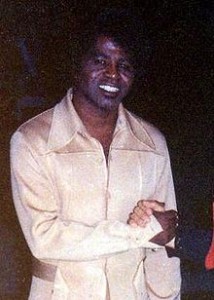 Brown after a concert in Tampa on Jan 29, 1972
Brown after a concert in Tampa on Jan 29, 1972
In March 1970, most of the members of Brown’s mid-to-late 1960s road band walked out on him due to money disputes. Additionally, The Famous Flames singing group disbanded for the same reason, with only original and founding member Bobby Byrd electing to remain with Brown. Brown and Byrd subsequently recruited several members of the Cincinnati-based The Pacemakers, which included Bootsy Collins and his brother Phelps “Catfish” Collins; augmented by the remaining members of the 1960s road band (including Fred Wesley, who rejoined Brown’s outfit in December 1970) and other newer musicians, they would form the nucleus of The J.B.’s, Brown’s new backing ensemble. Shortly following their first performance together, the band entered the studio to record the Brown-Byrd composition, “Get Up (I Feel Like Being a) Sex Machine“; the song and other contemporaneous singles would further concretize Brown’s influence in the nascent genre of funk music. This iteration of the J.B.’s dissolved after a March 1971 European tour (documented on the 1991 archival release Love Power Peace) due to additional money disputes and Bootsy Collins’ use of LSD; the Collins brothers would soon become integral members of Parliament-Funkadelic, while a new lineup of the J.B.’s coalesced around Wesley, St. Clair Pinckney, and drummer John Starks.
In 1971, Brown began recording for Polydor Records which also took over distribution of Brown’s King Records catalog. Many of his sidemen and supporting players, including Fred Wesley & the J.B.’s, Bobby Byrd, Lyn Collins, Vicki Anderson and former rival Hank Ballard, released records on the People label, an imprint founded by Brown that was purchased by Polydor as part of Brown’s new contract. The recordings on the People label, almost all of which were produced by Brown himself, exemplified his “house style”. Songs such as “I Know You Got Soul” by Bobby Byrd, “Think (About It)” by Lyn Collins and “Doing It to Death” by Fred Wesley & the J.B.’s are considered as much a part of Brown’s recorded legacy as the recordings released under his own name. That year, he also began touring African countries and was received well by audiences there. During the 1972 presidential election, James Brown openly proclaimed his support of Richard Nixon for reelection of the presidency over Democrat candidate George McGovern. The decision led to a boycott of his performances and, according to Brown, cost him a big portion of his black audience. As a result Brown’s record sales and concerts in the United States reached a lull in 1973 as he failed to land a number-one R&B single that year. Brown relied more on touring outside the United States where he continued to perform for sold-out crowds in cities such as London, Paris and Lausanne. That year, Brown also faced problems with the IRS for failure to pay back taxes, charging he hadn’t paid upwards of $4.5 million, five years earlier, the IRS claimed he owed nearly $2 million.
In 1973, Brown provided the score for the blaxploitation film Black Caesar. He also recorded another soundtrack for the film, Slaughter’s Big Rip-Off. Following the release of these soundtracks, Brown acquired a self-styled nickname, “The Godfather of Soul”, which remains his most popular nickname. In 1974, he returned to the No. 1 spot on the R&B charts with “The Payback“, with the parent album reaching the same spot on the album charts; he would reach No. 1 two more times in 1974 including “My Thang” and “Papa Don’t Take No Mess“. Later that year, he returned to Africa and performed in Kinshasa as part of the buildup to The Rumble in the Jungle fight between Muhammad Ali and George Foreman. Admirers of Brown’s music, including Miles Davisand other jazz musicians, began to cite Brown as a major influence on their own styles. However, Brown, like others who were influenced by his music, also “borrowed” from other musicians. His 1976 single “Hot (I Need To Be Loved, Loved, Loved, Loved)” (R&B #31) used the main riff from “Fame” by David Bowie, not the other way around as was often believed. The riff was provided to “Fame” co-writers John Lennon and Bowie by guitarist Carlos Alomar, who had briefly been a member of Brown’s band in the late 1960s.
Brown’s “Papa Don’t Take No Mess” would be his final single to reach the No. 1 spot on the R&B charts and his final Top 40 pop single of the 1970s, though Brown continued to occasionally have Top 10 R&B recordings. Among his top ten R&B hits during this latter period included “Funky President (People It’s Bad)” and “Get Up Offa That Thing“, the latter song released in 1976 and aimed at musical rivals such as Barry White, The Ohio Players and K.C. and the Sunshine Band. Brown credited his then-second wife and two of their children as writers of the song to avoid concurrent tax problems with the IRS. Starting in October 1975, Brown produced, directed, and hosted Future Shock, an Atlanta-based television variety show which ran for three years.
1977–1988: Decline and resurgence
By 1977, Brown was no longer a dominant force in R&B. After “Get Up Offa That Thing”, thirteen of Brown’s late 1970s recordings for Polydor, failed to reach the Top 10 of the R&B chart, with only “Bodyheat” in 1976 and the disco-oriented “It’s Too Funky in Here” in 1979 reaching the R&B Top 15 and the ballad “Kiss in ’77” reaching the Top 20. After 1976’s “Bodyheat”, he also failed to appear on the Billboard Hot 100. As a result, Brown’s concert attendance began dropping and reported disputes with the IRS caused Brown’s empire to collapse. In addition, Brown’s former band mates, including Fred Wesley, Maceo Parker and the Collins brothers, had found bigger success as members of George Clinton‘s Parliament-Funkadelic collective. The emergence of disco also stopped Brown’s success on the R&B charts as its slicker commercial style had superseded his rawer funk productions. Brown recorded disco material on his albums starting with 1975’s Sex Machine Today, producing less than favorable results.
By the release of 1979’s The Original Disco Man, Brown wasn’t providing much production or writing, leading most of it to producer Brad Shapiro, resulting in the song “It’s Too Funky in Here” becoming Brown’s most successful single in this period. After two more albums failed to chart, Brown left Polydor in 1981. It was around this time that Brown changed the name of his band from the J.B.’s to the Soul Generals (or Soul G’s). This band’s name remained that way until his death. Despite a fallout from record sales, Brown enjoyed something of a resurgence in this period starting with appearances in the feature films The Blues Brothers, Doctor Detroitand Rocky IV, as well as guest starring in the Miami Vice episode “Missing Hours” (1988). In 1984, Brown teamed with rap musician Afrika Bambaattaa on the song, “Unity“. A year later he signed with Scotti Brothers Records and issued the moderately successful album, Gravity, in 1986, which included Brown’s final Top 10 pop hit, “Living in America“, marking his first Top 40 entry since 1974 and his first Top 10 pop entry since 1968. Produced and written by Dan Hartman, it was also featured prominently on the Rocky IV film and soundtrack. Brown performed the song in the film at Apollo Creed’s final fight, shot in the Ziegfeld Room at the MGM Grand in Las Vegas and was credited in the film as “The Godfather of Soul.” 1986 also saw the publication of Brown’s autobiography, The Godfather of Soul, coauthored by Bruce Tucker. In 1987, Brown won the Grammy for Best Male R&B Vocal Performance for “Living in America.”
In 1988, Brown worked with the production team Full Force on the new jack swing-influenced album I’m Real, which spawned his final two Top 10 R&B hits, “I’m Real” and “Static“, which peaked at No. 2 and No. 5, respectively, on the R&B charts. Meanwhile, the drum break from the second version of the original 1969 hit “Give It Up Or Turnit A Loose” (the recording included on the compilation album In the Jungle Groove) became so popular at hip hop dance parties (especially for breakdance) during the late 1970s and early 1980s that hip hop founding father Kurtis Blow called the song “the national anthem of hip hop.”
1991–2006: Final years
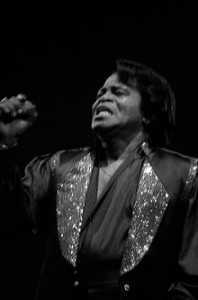 James Brown in Belgrade in 1993
James Brown in Belgrade in 1993
After his stint in prison during the late 1980s, Brown returned with the album Love Over-Due in 1991. It included the single “(So Tired Of Standing Still We Got To) Move On“, which peaked at No. 48 on the R&B chart. His former record label Polydor also released the four-CD box set, Star Time, spanning Brown’s career to date. Brown’s release from prison also prompted his former record labels to reissue his albums on CD, featuring additional tracks and commentary by music critics and historians. That same year, Brown appeared on rapper MC Hammer‘s video for “Too Legit to Quit.” Hammer had been noted, alongside Big Daddy Kane, for bringing Brown’s unique stage shows and their own energetic dance moves to the hip-hop generation, with both Hammer and Kane listing Brown as their idol. Both musicians also sampled Brown’s work, with Hammer having sampled the rhythms from “Super Bad” for his song, “Here Comes the Hammer”, from his best-selling album, Please Hammer, Don’t Hurt ‘Em. Before the year was over, Brown, who had immediately returned to work with his band following his release, organized a pay-per-view concert following a show at Los Angeles’ Wiltern Theatre, that was well received.
Brown continued making recordings. In 1993, his album Universal James was released. It included his final Billboard charting single, “Can’t Get Any Harder“, which peaked at No. 76 on the US R&B chart and reached No. 59 on the UK chart. Its brief charting in the UK was probably due to the success of a remixed version of “I Feel Good” featuringDakeyne. Brown also released the singles, “How Long” and “Georgia-Lina”, which failed to chart. In 1995 Brown returned to the Apollo and recorded Live at the Apollo 1995. It included a studio track titled “Respect Me”, which was released as a single; again it failed to chart. Brown’s final studio albums, I’m Back and The Next Step, were released in 1998 and 2002 respectively. I’m Back featured the song “Funk on Ah Roll“, which peaked at No. 40 in the UK but didn’t chart in his native America. The Next Step included Brown’s final single, “Killing Is Out, School Is In.” Both albums were produced by Derrick Monk. Brown’s concert success, however, remained unabated and Brown kept up with a grueling schedule throughout the remainder of his life, living up to his previous nickname, “The Hardest Working Man in Show Business”, in spite of his advanced age. In 2003, Brown participated in the PBS American Masters television documentary James Brown: Soul Survivor, which was directed by Jeremy Marre.
Brown celebrated his status as an icon by appearing in a variety of entertainment and sports events, including an appearance on the WCW pay-per-view event, SuperBrawl X, where he danced alongside wrestler Ernest “The Cat” Miller, who based his character on Brown, during his in-ring skit with The Maestro. Brown was then featured in Tony Scott‘s short film, Beat the Devil, in 2001. Brown was featured alongside Clive Owen, Gary Oldman, Danny Trejo and Marilyn Manson. Brown also made a cameo appearance in the 2002 Jackie Chan film The Tuxedo, in which Chan was required to finish Brown’s act after Brown was accidentally knocked out by Chan. In 2002, Brown appeared in Undercover Brother, playing himself.
The beginning of 2005 saw the publication of Brown’s second book, I Feel Good: A Memoir of a Life of Soul, written with Marc Eliot. He appeared at Edinburgh 50,000 – The Final Push, the final Live 8 concert on July 6, 2005, where he performed a duet with British pop star Will Young on “Papa’s Got A Brand New Bag”. He also performed a duet with another British pop star, Joss Stone, a week earlier on the United Kingdom chat show Friday Night with Jonathan Ross. Before his death, Brown was scheduled to perform a duet with singer Annie Lennox on the song “Vengeance” for her new album Venus, which was released in 2007. In 2006, Brown continued his “Seven Decades Of Funk World Tour”, his last concert tour where he performed all over the world. His final U.S. performances were in San Francisco on August 20, 2006, as headliner at the Festival of the Golden Gate (Foggfest) on the Great Meadow at Fort Mason. The following day, August 21, he performed at Humboldt State University in Arcata, CA, at a small theatre (800 seats) on campus. His last shows were greeted with positive reviews, and one of his final concert appearances at the Irish Oxegen festival in Punchestown in 2006 was performed for a record crowd of 80,000 people. Brown’s last televised appearance was at his induction into the UK Music Hall of Fame in November 2006, before his death the following month.
 Civil rights and self-reliance
Civil rights and self-reliance
Brown and his band first participated in benefit concerts for civil rights groups starting in 1965, performing for organizations such as the SCLC. In 1968, Brown recorded two socially conscious songs, “America Is My Home” and “Say It Loud – I’m Black and I’m Proud.” The former song, in which Brown performed a rap, advocated patriotism, pointing out that America was one of the few countries where “you can start as a shoeshine boy and shake hands with the President” and exhorting listeners to “stop pitying yoursel[ves] and get up and fight.” This coincided with Brown’s participation in performing in front of troops during the Vietnam War.
“Say It Loud” was written in response to pressure from black activists for Brown to take a bigger stance on their issues. The song was inspired by television coverage of black on black crime as well as concurrent issues concerning the riots that occurred following the assassination of Martin Luther King, Jr.. Brown wrote the words and asked his bandleader at the time, Alfred “Pee Wee” Ellis, to compose the music. The song’s lyrics helped to make it an anthem to the civil rights movement. Some critics later stated that the song had gotten through to black youths better than some civil rights leaders’ speeches. Throughout the remainder of his career and after his death, Brown was credited by some of his admirers for “destroying the word Negro from the vocabulary and making it cool to call yourself ‘Black‘.” Brown performed “Say It Loud” only sporadically after 1969, later stating in his 1986 autobiography:
The song is obsolete now… But it was necessary to teach pride then, and I think the song did a lot of good for a lot of people… People called “Black and Proud” militant and angry – maybe because of the line about dying on your feet instead of living on your knees. But really, if you listen to it, it sounds like a children’s song. That’s why I had children in it, so children who heard it could grow up feeling pride… The song cost me a lot of my crossover audience. The racial makeup at my concerts was mostly black after that. I don’t regret it, though, even if it was misunderstood.”
He performed in front of a televised audience in Boston the day after Dr. King’s death (a show released on DVD as Live at the Boston Garden: April 5, 1968). Brown has been often given credit for preventing rioting with the performance though this was disputed in the PBS/VH-1 special, The Night James Brown Saved Boston. Mayor Kevin White strongly restrained the Boston Police from cracking down on minor violence and protests after the assassination, and Boston religious and community leaders worked to keep tempers from flaring. Also, White arranged to have the Brown performance broadcast multiple times on Boston’s public television station, WGBH, thus keeping many potential rioters off the streets, watching the concert for free. Brown demanded $60,000 for “gate” fees (money he thought would be lost from ticket sales on account of the concert being broadcast for free), and then threatened to go public about the secret arrangement when the city balked at paying up after the concert, news of which would have been a political death-blow to White, and possibly sparked riots on its own. White successfully lobbied the behind-the-scenes power-brokering group known as “The Vault” to come up with money for Brown’s gate fee and other social programs; The Vault contributed $100,000 to such programs, and Brown received $15,000 from them via the city. White persuaded management at the Boston Garden to give up their share of receipts to make up the difference.
Brown was then advised by the then current administration of President Johnson to travel to riot-torn black communities and advise the youth to “cool it, there is another way” of addressing racism and other issues. In 1971, he was made “freeman of the city” in Lagos, Nigeria after performing there by Oba Adeyinka Oyekan, for his “influence on Black people all over the world.” With his company, James Brown Enterprises, Brown helped to provide jobs for blacks in businesses in the communities. Though Brown seemed to show support toward causes to improve the conditions of youths, he was against anything that he felt went against his beliefs, often criticizing militant black leaders in songs such as “Get Up, Get Into It, Get Involved” and “Talkin’ Loud and Sayin’ Nothing,” the latter song in which he was often accused of not doing more for blacks. Brown also recorded songs supporting self-reliance, including “I Don’t Want Nobody to Give Me Nothing (Open Up the Door, I’ll Get It Myself).” As the early 1970s continued, he performed songs of other social matters that were troubling the black community including drug abuse in the song, “King Heroin,” in 1972.
Political views
Though Democrat Lyndon B. Johnson was the one who convinced Brown to go to riot-torn inner cities in the wake of the King assassination, Brown was a staunch Republican. Although he initially spoke at political rallies with Hubert Humphrey, following the riots that engaged during the 1968 Democratic National Convention, Brown switched his endorsement to Richard Nixon and was one of the few Black celebrities to do so. During the 1972 presidential election, Brown again endorsed Nixon for his second term. Because of a perceived heavily negative view of Nixon by blacks, Brown’s records faced boycott in several radio stations across the country as a result of angry black leaders’ disapproval at Brown’s stance. Some of the singer’s concerts during this time were protested. Brown also upset black liberals by agreeing to perform for troops during the Vietnam War despite the public’s growing opposition against the war at the time.
In 1999, when being interviewed by Rolling Stone, the magazine asked him to name a hero in the 20th century, Brown mentioned Republican Senator Strom Thurmond, stating “when the young whippersnappers get out of line, whether Democrat or Republican, an old man can walk up and say ‘Wait a minute, son, it goes this way.’ And that’s great for our country. He’s like a grandfather to me.” Thurmond and his son eventually helped to get Brown be released on parole from his six-year prison sentence in 1991. In 2003, Brown was the featured attraction of a D.C. fundraiser for the National Republican Senatorial Committee. Following the deaths of Ronald Reagan and his friend and fellow Republican Ray Charles, Brown said to CNN, “I’m kind of in an uproar. I love the country and I got – you know I’ve been around a long time, through many presidents and everything. So after losing Mr. Reagan, who I knew very well, then Mr. Ray Charles, who I worked with and lived with like, all our life, we had a show together in Oakland many, many years ago and it’s like you found the placard.”
Personal life
At the end of his life, James Brown lived in a riverfront home in Beech Island, South Carolina, directly across the Savannah River from Augusta, Georgia. Brown had diabetes that went undiagnosed for years, according to his longtime manager Charles Bobbit. In 2004 Brown was successfully treated for prostate cancer. Regardless of his health, Brown maintained his reputation as the “hardest working man in show business” by keeping up with his grueling performance schedule.
Marriages and children
Brown was married three times — Velma Warren (1953–1969, divorced), Deidre “Deedee” Jenkins (October 22, 1970 – January 10, 1981, divorced) and Adrienne Lois Rodriguez (March 9, 1950 – January 6, 1996) (1984–1996, wife’s death). He also had a relationship with Tomi Rae Hynie (2001–2004). From these and other relationships, James Brown had five sons — Teddy Brown (1954–1973), Terry Brown, Larry Brown, Daryl Brown (a member of Brown’s backing band) and James Joseph Brown II, in addition to four daughters — Lisa Brown, Dr. Yamma Noyola Brown Lumar, Deanna Brown Thomas and Venisha Brown. Brown also had eight grandchildren and four great-grandchildren. Brown’s eldest son, Teddy, died in a car crash on June 14, 1973. According to an August 22, 2007 article published in the British newspaper The Daily Telegraph, DNA tests indicate that Brown also fathered at least three extramarital children. The only one of them who has been identified is LaRhonda Pettit (born 1962), a retired air stewardess and teacher who lives in Houston.
Brown-Hynie marriage controversy
Much controversy surrounds Tomi Rae Hynie‘s marriage to James Brown on December 23, 2002, officiated by Rev. Larry Fryer. Brown’s longtime attorney, Albert “Buddy” Dallas, reported that the marriage between Brown and Hynie was not valid because Hynie was married at that time to Javed Ahmed, a Bangladeshi whom Hynie claimed married her for a Green Card in an immigration fraud. Although Hynie stated that her marriage to Javed Ahmed was later annulled, this annulment did not occur until April 2004. In an interview on CNN with Larry King, Hynie produced a 2001 marriage certificate as proof of her marriage to James Brown, but she did not provide King with court records pointing to an annulment of her marriage to him or to Ahmed.
According to Dallas, Brown was angry and hurt that Hynie concealed her prior marriage from him, and that Brown moved to file for annulment from Hynie. Dallas added that, although Hynie’s marriage to Javed Ahmed was annulled after she married James Brown, the Brown-Hynie marriage was not valid under South Carolina law because Brown and Hynie did not remarry after the annulment. In August 2003, Brown took out a full-page public notice in Variety Magazine featuring Hynie, James II and himself on vacation at Disney World to announce that he and Hynie were going their separate ways.
Paternity of James Brown II
In a separate CNN interview, Debra Opri, another Brown family attorney, revealed to Larry King that Brown wanted a DNA test performed after his death to confirm the paternity of James Brown II — not for Brown’s sake, but for the sake of the other family members. In April 2007, Hynie selected a guardian ad litem whom she wants appointed by the court to represent her son, James Brown II, in the paternity proceedings.
Throughout the first 25 professional years of his career, Brown was known to carry around a drug-free policy with any member of his entourage, including his band, firing people for disobeying orders, especially those who would use or abuse drugs. Brown’s policy caused some of the “interim members” of Brown’s vocal group The Famous Flames being fired for their usage of drugs and alcohol. Noting of this policy, some of the original members of Brown’s 1970s band, The J.B.’s including the Collins brothers, Catfish and Bootsy, intentionally got high on acid during a 1971 concert gig, causing Brown to fire them after the show because he had suspected them to be on drugs all along, according to Bootsy Collins.
Though this policy maintained through the mid-1970s, by the end of the decade, it was alleged that Brown himself had started to use drugs. By the mid-1980s, after meeting and marrying Adrienne Rodriguez, she and Brown began using PCP, or “angel dust”. A PCP-triggered Brown would be later arrested several times in the mid-1980s and early-1990s for domestic violence against Rodriguez. After being arrested in May 1988 for allegedly hitting Rodriguez with a lead pipe and shooting at her in their car during an argument, Brown went on TV with a local Los Angeles reporter via satellite from Atlanta and appeared to be behaving erratically in response to some of the interviewer’s questions, refusing to talk about the domestic issue with Rodriguez but instead wanted to bring more focus on his professional work including an upcoming tour of Brazil; at one point Brown began shouting out his song titles to one of the reporter’s questions. This interview was later satirized by comedian Cedric the Entertainer during an appearance on Comic View. The interview later went viral in the early years of the new millennium and led some assuming that Brown was either drunk or doped up.
One of Brown’s former mistresses recalled in an GQ magazine article on Brown some years after his death that Brown would smoke PCP “until that got hard to find”, and cocaine, mixed with tobacco in Kools cigarettes. In January 1998, he spent a week in rehab to deal with an addiction to prescription painkillers; a week following his release, he was arrested for an unlawful use of a handgun and possession of marijuana.
Brown’s personal life was marred by several brushes with the law. At the age of 16, he was arrested for theft and served 3 years in prison. In 1978, while in concert at the Apollo, Brown was arrested onstage for failing to comply with a government order to leave the country during a payola investigation of his radio stations. In 1988, Brown was arrested twice, first for drugs and weapons charges in May, and later in September of that year following an alleged high-speed car chase on Interstate 20 near the Georgia–South Carolina state border. He was convicted of carrying an unlicensed pistol and assaulting a police officer, along with various drug-related and driving offenses. Although he was sentenced to six years in prison, he was eventually released in 1991 after serving only three years of his sentence. Brown’s FBI file, released to The Washington Post in 2007 under the Freedom of Information Act, related Brown’s claim that the high-speed chase did not occur as claimed by the police, and that local police shot at his car several times during an incident of police harassment and assaulted him after his arrest. Local authorities found no merit to Brown’s accusations.
In another incident, the police were summoned to Brown’s residence on July 3, 2000 after he was accused of charging at an electric company repairman with a steak knife when the repairman visited Brown’s house to investigate a complaint about having no lights at the residence. In 2003, Brown was pardoned by the South Carolina Department of Probation, Parole, and Pardon Services for past crimes that he was convicted of committing in South Carolina.
For the remainder of his life, Brown was repeatedly arrested for domestic violence. Adrienne Rodriguez, his third wife, had him arrested four times between 1987 and 1995 on charges of assault. In January 2004, Brown was arrested in South Carolina on a domestic violence charge after Tomi Rae Hynie accused him of pushing her to the floor during an argument at their home, where she suffered scratches and bruises to her right arm and hip. Later that year in June 2004, Brown pleaded no contest to the domestic violence incident, but served no jail time. Instead, Brown was required to forfeit a US$1,087 bond as punishment.
In January 2005, a woman named Jacque Hollander filed a lawsuit against James Brown, which stemmed from an alleged 1988 forcible rape. When the case was initially heard before a judge in 2002, Hollander’s claims against Brown were dismissed by the court as the limitations period for filing the suit had expired. Hollander claimed that stress from the alleged assault later caused her to contract Graves’ Disease, a thyroid condition. Hollander claimed that the incident took place in South Carolina while she was employed by Brown as a publicist. Hollander alleged that, during her ride in a van with Brown, Brown pulled over to the side of the road and sexually assaulted her while he threatened her with a shotgun. In her case against Brown, Hollander entered as evidence a DNA sample and a polygraph result, but the evidence was not considered due to the limitations defense. Hollander later attempted to bring her case before the Supreme Court but nothing became of her complaint.
Death and aftermath – Death
On December 23, 2006, Brown became very ill and arrived at his dentist’s office in Atlanta, Georgia, several hours later than his appointment for dental implant work. During that visit, Brown’s dentist observed that Brown looked “very bad … weak and dazed.” Instead of performing the dental work, the dentist advised Brown to see a doctor right away about his medical condition.
Brown checked in at the Emory Crawford Long Memorial Hospital the next day for a medical evaluation of his condition, and he was admitted to the hospital for observation and treatment. According to Charles Bobbit, Brown’s longtime personal manager and friend, Brown had been sick and suffering with a noisy cough since he returned from a November trip to Europe. Bobbit also added that it was characteristic of Brown to never complain about being sick, and that he frequently performed during illness. Although Brown had to cancel upcoming shows in Waterbury, Connecticut and Englewood, New Jersey, Brown was confident that the doctor would discharge him from the hospital in time to perform the New Year’s Eve shows. For the New Year’s celebrations, Brown was scheduled to perform at the Count Basie Theatre in New Jersey and at the B. B. King Blues Club in New York, in addition to performing a song live on CNN for the Anderson Cooper New Year’s Eve special. However, Brown remained hospitalized, and his medical condition worsened throughout that day.
On Christmas Day 2006, Brown died at approximately 1:45 am EST (06:45 UTC) from congestive heart failure resulting from complications of pneumonia, with his personal manager and longtime friend Charles Bobbit at his bedside. According to Mr. Bobbit, Brown stuttered “I’m going away tonight”, and then Brown took three long, quiet breaths and fell asleep before dying.
Memorial services
After Brown’s death, Brown’s relatives and friends, a host of celebrities and thousands of fans attended public memorial services at the Apollo Theater in New York on December 28, 2006 and at the James Brown Arena on December 30, 2006 in Augusta, Georgia. A separate, private memorial service was also held in North Augusta, South Carolina on December 29, 2006, which was attended by Brown’s family and close friends. Celebrities who attended Brown’s public and/or private memorial services included Michael Jackson, Jimmy Cliff, Joe Frazier, Buddy Guy, Ice Cube, Ludacris, Dr. Dre, Little Richard, Dick Gregory, MC Hammer, Prince, Jesse Jackson, Ice-T, Jerry Lee Lewis, Bootsy Collins, LL Cool J, Li’l Wayne, Lenny Kravitz, 50 Cent, Stevie Wonder, and Don King, among others. All of the public and private memorial services were officiated by Rev. Al Sharpton.
Brown’s public and private memorial ceremonies were elaborate, complete with costume changes for Brown and videos featuring him in concert performances. Brown’s body, which was placed in a Promethean casket, which is bronze polished to a golden shine, was driven through the streets of New York to the Apollo Theater in a white, glass-encased horse-drawn carriage. In Augusta, Georgia, the procession for Brown’s public memorial visited Brown’s statue as the procession made its way to the James Brown Arena. During the public memorial at the James Brown Arena, nachos and pretzels were served to mourners, as a video showed Brown’s last performance in Augusta, Georgia and the Ray Charles version of “Georgia on My Mind” played soulfully in the background. Brown’s last backup band, The Soul Generals, also played the music of Brown’s hits during the memorial service at the James Brown Arena. The group was joined by Bootsy Collins on bass, with MC Hammer performing a dance in James Brown style. Former Temptations lead singer Ali-Ollie Woodson performed “Walk Around Heaven All Day” at the memorial services (to read more about James Brown, go to the link above).
http://en.wikipedia.org/wiki/James_Brown

